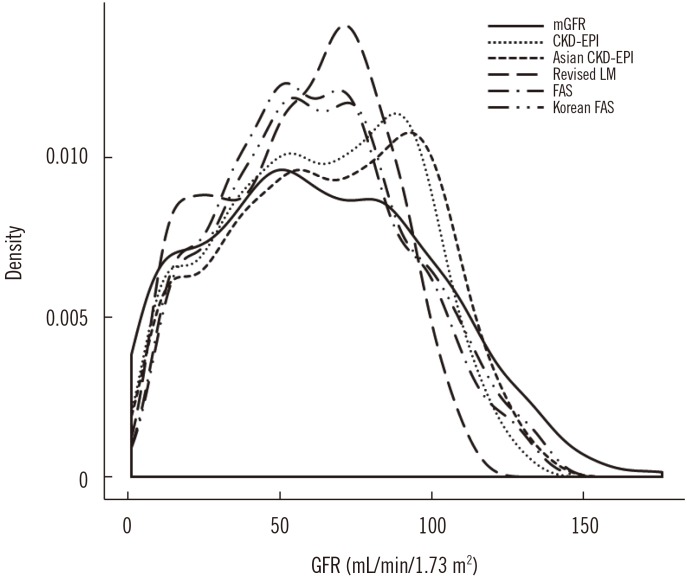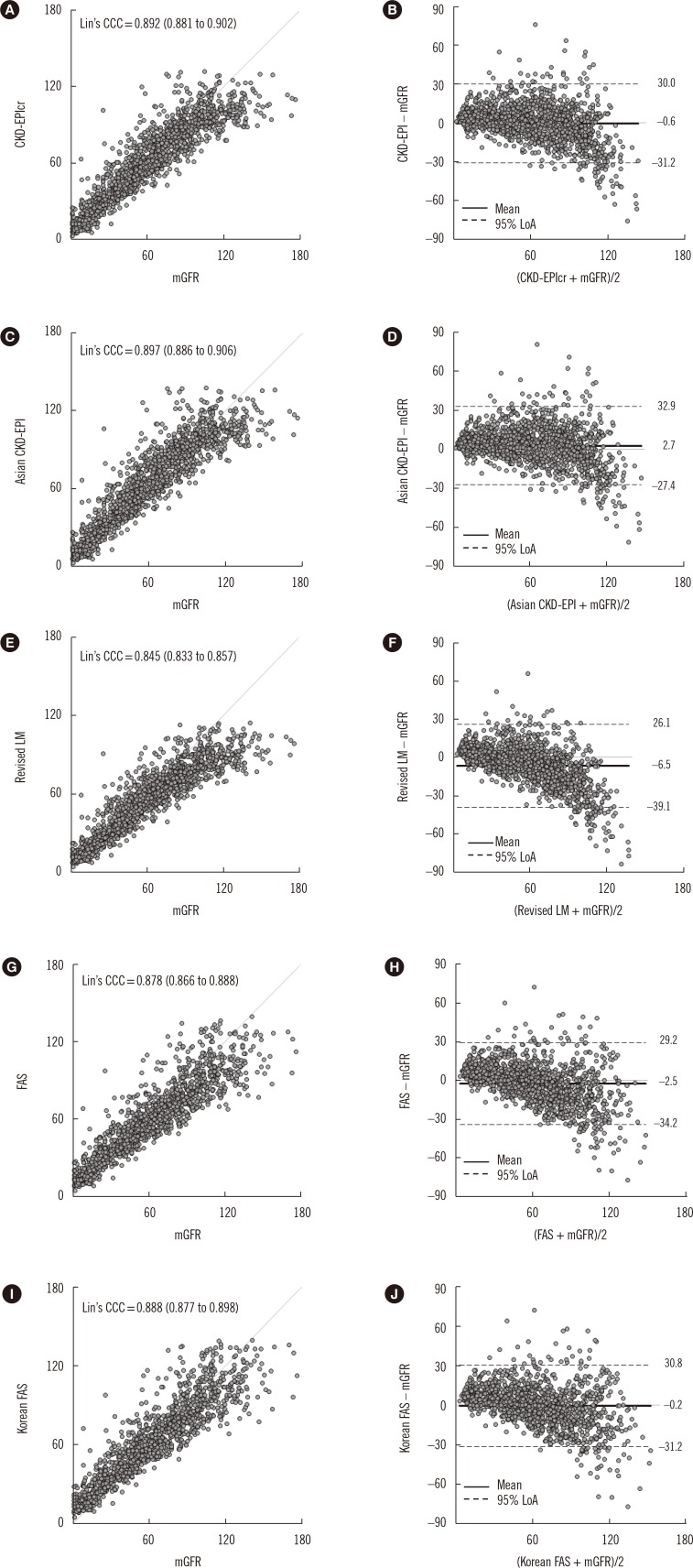Ann Lab Med.
2017 Sep;37(5):371-380. 10.3343/alm.2017.37.5.371.
Accuracy Assessment of Five Equations Used for Estimating the Glomerular Filtration Rate in Korean Adults
- Affiliations
-
- 1Department of Laboratory Medicine, College of Medicine, Ewha Womans University, Seoul, Korea.
- 2Department of Laboratory Medicine, University of Ulsan College of Medicine and Asan Medical Center, Seoul, Korea. wkmin@amc.seoul.kr
- KMID: 2383912
- DOI: http://doi.org/10.3343/alm.2017.37.5.371
Abstract
- BACKGROUND
We aimed to assess the performance of the five creatinine-based equations commonly used for estimates of the glomerular filtration rate (eGFR), namely, the creatinine-based Chronic Kidney Disease Epidemiology Collaboration (CKD-EPIcr), Asian CKD-EPI, revised Lund-Malmö (revised LM), full age spectrum (FAS), and Korean FAS equations, in the Korean population.
METHODS
A total of 1,312 patients, aged 20 yr and above who underwent âµ¹Cr-EDTA GFR measurements (mGFR), were enrolled. The bias (eGFR-mGFR) and precision (root mean square error [RMSE]) were calculated. The accuracy (P30) of four eGFR equations was compared to that of the CKD-EPIcr equation. P30 was defined as the percentage of patients whose eGFR was within±30% of the mGFR.
RESULTS
The mean bias (mL·min⻹·1.73 m⻲) of the five eGFR equation was as follows: CKD-EPIcr, -0.6; Asian CKD-EPI, 2.7; revised LM, -6.5; FAS, -2.5; and Korean FAS, -0.2. The bias of the Asian CKD-EPI, revised LM, and FAS equations showed a significant difference from zero (P<0.001). The RMSE values were as follows: CKD-EPIcr, 15.6; Asian CKD-EPI, 15.6; revised LM, 17.9; FAS, 16.3; and Korean FAS, 15.8. There were no significant differences in the P30 except for the Asian CKD-EPI equation: CKD-EPIcr, 76.6%; Asian CKD-EPI, 74.7%; revised LM, 75.8%; FAS, 76.0%; and Korean FAS, 75.8%.
CONCLUSIONS
The CKD-EPIcr and Korean FAS equations showed equivalent analytical and clinical performances in the Korean adult population.
Keyword
MeSH Terms
Figure
Cited by 1 articles
-
Recent Trends in Creatinine Assays in Korea: Long-Term Accuracy-Based Proficiency Testing Survey Data by the Korean Association of External Quality Assessment Service (2011–2019)
Tae-Dong Jeong, Eun-Jung Cho, Kyunghoon Lee, Woochang Lee, Yeo-Min Yun, Sail Chun, Junghan Song, Won-Ki Min
Ann Lab Med. 2021;41(4):372-379. doi: 10.3343/alm.2021.41.4.372.
Reference
-
1. National Kidney Foundation. K/DOQI clinical practice guidelines for chronic kidney disease: evaluation, classification, and stratification. Am J Kidney Dis. 2002; 39(2 Suppl 1):S1–S266. PMID: 11904577.2. Levey AS, Stevens LA, Schmid CH, Zhang YL, Castro AF 3rd, Feldman HI, et al. A new equation to estimate glomerular filtration rate. Ann Intern Med. 2009; 150:604–612. PMID: 19414839.3. Inker LA, Astor BC, Fox CH, Isakova T, Lash JP, Peralta CA, et al. KDOQI US commentary on the 2012 KDIGO clinical practice guideline for the evaluation and management of CKD. Am J Kidney Dis. 2014; 63:713–735. PMID: 24647050.4. Kidney Disease: Improving Global Outcomes (KDIGO) CKD Work Group. KDIGO 2012 Clinical Practice Guideline for the Evaluation and Management of Chronic Kidney Disease. Kidney Int Suppl (2011). 2013; 3:1–150.5. Nyman U, Grubb A, Larsson A, Hansson LO, Flodin M, Nordin G, et al. The revised Lund-Malmö GFR estimating equation outperforms MDRD and CKD-EPI across GFR, age and BMI intervals in a large Swedish population. Clin Chem Lab Med. 2014; 52:815–824. PMID: 24334413.6. Björk J, Grubb A, Sterner G, Nyman U. Revised equations for estimating glomerular filtration rate based on the Lund-Malmö Study cohort. Scand J Clin Lab Invest. 2011; 71:232–239. PMID: 21391777.7. Pottel H, Hoste L, Dubourg L, Ebert N, Schaeffner E, Eriksen BO, et al. An estimated glomerular filtration rate equation for the full age spectrum. Nephrol Dial Transplant. 2016; 31:798–806. PMID: 26932693.8. Earley A, Miskulin D, Lamb EJ, Levey AS, Uhlig K. Estimating equations for glomerular filtration rate in the era of creatinine standardization: a systematic review. Ann Intern Med. 2012; 156:785–795. PMID: 22312131.9. Ji M, Lee YH, Hur M, Kim H, Cho HI, Yang HS, et al. Comparing results of five glomerular filtration rate-estimating equations in the Korean general population: MDRD Study, revised Lund-Malmö, and three CKD-EPI equations. Ann Lab Med. 2016; 36:521–528. PMID: 27578504.10. CLSI. Defining, establishing, and verifying reference intervals in the clinical laboratory. Approved Guideline-Third Edition. CLSI document EP28-A3c. Wayne, PA: Clinical and Laboratory Standards Institute;2008.11. Jeong TD, Lee W, Yun YM, Chun S, Song J, Min WK. Development and validation of the Korean version of CKD-EPI equation to estimate glomerular filtration rate. Clin Biochem. 2016; 49:713–719. PMID: 26968101.12. Stevens LA, Claybon MA, Schmid CH, Chen J, Horio M, Imai E, et al. Evaluation of the Chronic Kidney Disease Epidemiology Collaboration equation for estimating the glomerular filtration rate in multiple ethnicities. Kidney Int. 2011; 79:555–562. PMID: 21107446.13. McBride GB. A proposal for strength-of-agreement criteria for Lin's concordance correlation coefficient. NIWA Client Report;2005. p. HAM2005-062.14. Delanaye P, Cavalier E, Mariat C, Krzesinski JM, Rule AD. Estimating glomerular filtration rate in Asian subjects: where do we stand? Kidney Int. 2011; 80:439–440. PMID: 21841830.15. Björk J, Grubb A, Sterner G, Back SE, Nyman U. Performance of GFR estimating equations stratified by measured or estimated GFR: Implications for interpretation. Am J Kidney Dis. 2015; 66:1107–1108. PMID: 26363849.16. Björk J, Grubb A, Larsson A, Hansson LO, Flodin M, Sterner G, et al. Accuracy of GFR estimating equations combining standardized cystatin C and creatinine assays: a cross-sectional study in Sweden. Clin Chem Lab Med. 2015; 53:403–414. PMID: 25274955.
- Full Text Links
- Actions
-
Cited
- CITED
-
- Close
- Share
- Similar articles
-
- Performance comparison of estimated glomerular filtration rate equations
- The new race-free equations for estimating glomerular filtration rate: should they be adopted for Asians?
- The Value of Serum Concentration of Cystatin C as a Marker for Glomerular Filtration Rate in Children and Adolescents
- Accuracy of the New Creatinine-based Equations for Estimating Glomerular Filtration Rate in Koreans
- Interpretation of Estimated Glomerular Filtration Rate



